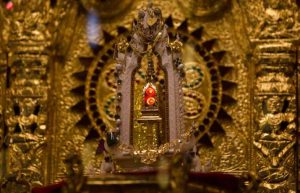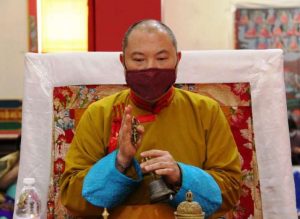Shambhala Publications released Tibetan Buddhism: A Guide to Contemplation, Meditation, and Transforming Your Mind by Khenpo Sodargye, translated by the Wisdom and Compassion Translation Group, on 16 January 2024.
Khenpo Sodargye was born in Kham, Tibet, in 1962. He is a lama, a scholar, and a translator, ordained at the Larung Gar monastic academy in 1985 and a lineage holder in the Great Perfection tradition.
Khenpo’s book, inspired by the direct and concise teaching style passed down from the his root guru, Jigme Phuntsok Rinpoche, aims to present the Dharma in a clear and accessible manner, incorporating quotes from sutras and shastras for scriptural support, while urging readers to dig deeper into their further reading and, most importantly, to practice, practice, practice!

The author intends to demystify Mahayana Buddhism by looking into key concepts such as bodhichitta, rebirth, karma, and the Great Perfection. Drawing from authentic texts and the wisdom of respected Buddhist masters, Khenpo Sodargye’s book provides insights based on the systematic study and practice framework established at the Larung Gar Five Sciences Buddhist Academy. Lay practitioners, guided by Khenpo Sodargye’s teachings, follow a structured curriculum that typically begins with group study sessions covering fundamental topics and then progresses to in-depth exploration of classical texts, such as Patrul Rinpoche’s The Words of My Perfect Teacher. The completion of preliminary practices complements these studies.
In contrast to the common emphasis on meditation alone, Khenpo Sodargye advocates a balanced approach, integrating systematic study and practice. The transformative journey of practitioners, marked by the growth of love, compassion, and an awareness of the nature of the mind, is also discussed within the pages of this book.
The Wisdom and Compassion Translation Group, led by Khenpo Sodargye, undertook the translation of these texts as a means to share Tibetan Buddhist wisdom globally.
Drawing an analogy to a thangka painting, the book is compared to a pencil sketch outlining the Mahayana Buddhist path, offering a broad perspective for those with limited time and energy. It introduces essential themes, including the Four Dharma Seals that form the core of Buddha’s teachings, affirming that all compounded things are impermanent, all stained emotions cause suffering, all phenomena lack inherent existence, and only nirvana represents true peace.
The subsequent chapters cover topics and questions such as faith (what kind of faith do you have?); bodhicitta, rebirth, and karma (what’s the difference between reincarnation and rebirth?); spiritual teachers (is one teacher better than many, or even a teacher we may never meet? And “how do we know a good teacher from a fake guru?); meditation, the pinnacle of the practices of the Nyingma tradition; and concludes with an appendix on preparing for death.
The book begins with the genesis of Buddhism and the inevitable questions and narrative surrounding the historical Buddha. The narrative unravels the journey from Siddhartha Gauthama to the enlightened state, which naturally serves as a useful entry point for those less familiar with Buddhism, providing an historical overview, elucidating on terms, concepts, and lessons, drawing connections to contemporary scenarios, and employing some well-established tropes for clarity and relatability.
In his presentation of the core tenets of Buddhism, Khenpo Sodargye invites the reader to explore impermanence, suffering, the nature of phenomena, and the pursuit of nirvana. He also discusses the nuanced facets of faith, examining its expressions and evolution, especially for those new to the Buddhist teachings, as he simplifies sutra stories for beginners while serving as relevant reminders for more seasoned practitioners. I did appreciate the integration of faith into modern psychology, and how the act of “letting go” with complete trust enables a transformative reprogramming of the mind—something discussed at length in the field of neuroplasticity as well as more fringe conceptions of manifestation work.
The Buddhist perspective that phenomena are devoid of inherent existence is congruent with modern scientific discoveries, although it’s taken more than two millennia for science to begin to catch up. Quantum physics reveals that particles exist in a wave of probabilities until observed—an echo of emptiness—while neuroscientists explore the plasticity of the brain, challenging the dogma of fixed identity. This all invites us to question our assumptions, peel away layers of illusion, and recognize the fluidity of reality.
Khenpo Sodargye resists tailoring the teachings exclusively for Western audiences, instead emphasizing the universal significance of foundational Buddhist principles through diverse methods. This approach is certainly in line with my own perspective, given the frequent distortions and misinterpretations of these teachings in their Western journey. He is also far from shy in sharing some of his thoughts on how corrupted the teachings have become in some ignorant hands. One can still make an argument, however, that while the human brain hasn’t really changed in the last 2,500 years, our modern complexities have. A stark contrast exists between the oversimplified, almost naive interpretation of the Buddhist teachings appropriate for those earlier times and cultures, and the complex psychological patterns of the contemporary mind, which occasionally leaves some queries insufficiently addressed.
I certainly became aware of my therapist brain joining the conversation as I read sections such as that on Union Practice, a subject that I would enjoy debating further, as I would pose questions on the cited story used in both The Words of My Perfect Teacher and The Great Jewel Heap Sutra: firstly we don’t know for sure what thoughts the Brahmin was really motivated by; and secondly, by the same token, how many wives would prefer the vow of celibacy but find themselves being altruistic for their partner’s happiness on a frequent basis? I wonder just how much merit those women were accumulating. However light I may make of the subject, the idea of Consort Union has indeed been abused over many years, and used to legitimise unethical behaviour.
And then there’s Guru worship. When advocating devotion to a teacher, Khenpo Sodargye does emphasize the importance of finding a very good teacher. He does so without dwelling too long on the concerns that many of us have and have heard about—the abuse by gurus of young, over-eager students—and shares his thoughts regarding the lateral approach taken by a slew of generally well-meaning but sometimes profit-driven “retreat-runner” types. These individuals often cherrypick and, at times, completely misconstrue and convolute the teachings, sometimes leading to more harm than good.
Bodhicitta, the altruistic aspiration for enlightenment, arises from profound compassion. It’s not merely an intellectual understanding but a heartfelt commitment to alleviating suffering. When we grasp the fundamental nature of all things—the impermanence, interdependence, and emptiness—we glimpse the essence of bodhicitta. However, claiming this desire is no small feat. It demands unwavering dedication, selflessness, and a radical shift in perspective. Bodhicitta isn’t a solitary endeavour; it’s a bridge connecting us to all sentient beings.
It’s easy to perceive others as distinct entities, separate from ourselves. We construct mental boundaries, reinforcing the illusion of individuality. It’s easy to view others as separate and so work on our own liberation, or to claim the desire of boddhiccita because we intellectually understand the fundamental nature of all things. Yet these perspectives can hinder our progress. To truly liberate ourselves, Khenpo Sodargye reminds us, we must recognize this interconnectedness. Our own liberation is intertwined with that of every other being. When we work on our own liberation with the correct motivation, we simultaneously contribute to the collective awakening. This path requires introspection, empathy, and a willingness to dissolve the barriers that divide us.
The author shares stories exemplifying these different paths within Buddhism, and we’re reminded of how hard the latter path really is, as bodhicitta, with its altruistic orientation, presents a formidable challenge in a world rife with suffering. This ranges from seemingly pure malevolence causing immense pain, to the all-too-familiar yearning to heal one’s personal wounds, be they severe trauma or feelings of invisibility since early childhood. Moreover, the task of distinguishing between ego-driven ambition and the, in my view, perilous path of self-negation, is daunting. This is particularly true when juxtaposed with the prajnaparamitas, which represent the ultimate nature of reality.
Oh, the complex interplay of self, suffering, and reality!
Khenpo Sodargye’s pithy pages are at once a balm and a guide for the seeker. We could liken this book to an updated rendition of The Words of My Perfect Teacher, with all its spiritual guidance offering timeless wisdom and practical teachings. The author emphasizes the significance of absolute conviction, and he reminds us that blessings hold little value without unwavering faith and right motivation. Khenpo Sodargye is also a firm advocate of compassion in action, stressing the futility of seeking enlightenment without actively embodying goodness and expressing gratitude, which should be the primary motivation behind practising Buddhism, and this fundamental advocacy is evident throughout this book.
See more
Tibetan Buddhism: A Guide to Contemplation, Meditation, and Transforming Your Mind (Shambhala Publications)
Related features from BDG
Book Review: Embodying Tara: Twenty-One Manifestations to Awaken Your Innate Wisdom
Book Review: Red Tara: The Female Buddha of Power and Magnetism
Book Review: The Power of Mind: A Tibetan Monk’s Guide to Finding Freedom in Every Challenge













